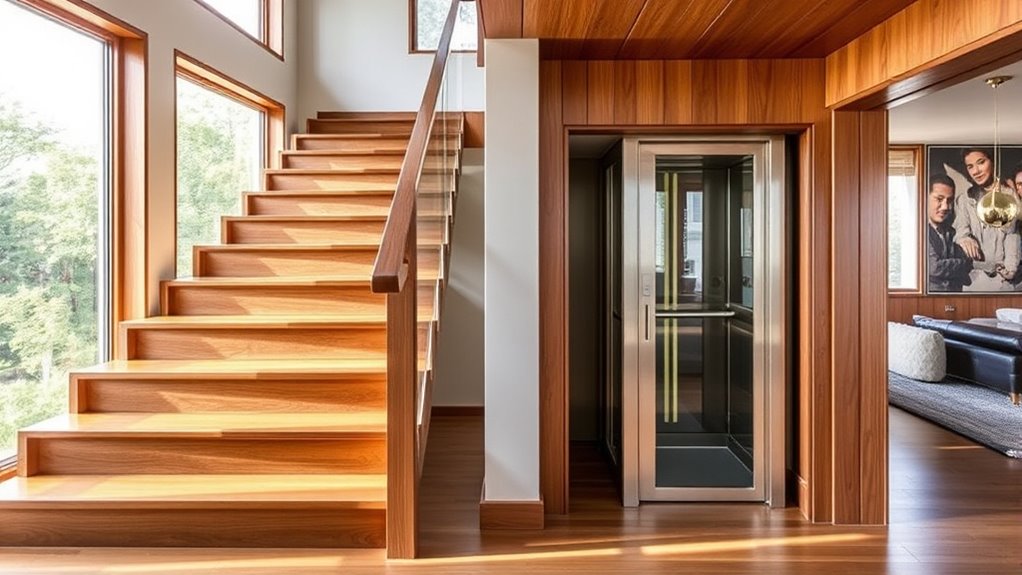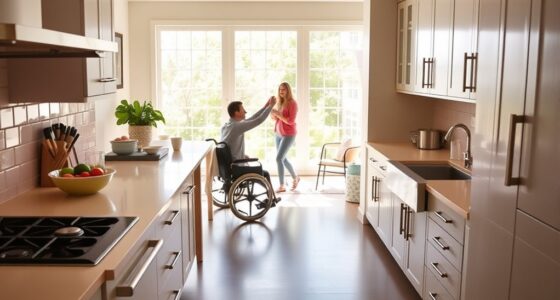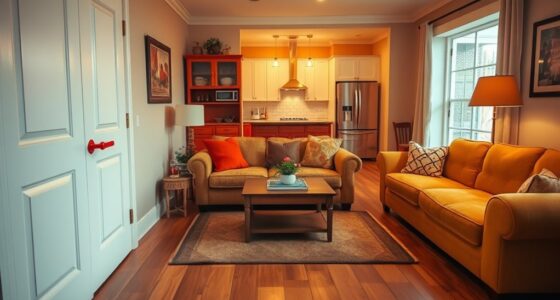To create an accessible home, consider adding ramps and lifts tailored to your space. Ramps are a great low-profile, cost-effective option that can blend seamlessly with your entryways, while lifts like stairlifts and platform lifts offer reliable multi-story access. Both solutions improve safety and independence without sacrificing style. If you want to explore the best options for your home and learn how to integrate them effectively, there’s more to discover below.
Key Takeaways
- Ramps provide seamless wheelchair access and customizable safety features, blending functionality with home aesthetics.
- Lifts like stairlifts and platform lifts offer unobtrusive, safe solutions for multi-story mobility.
- Safety enhancements such as textured surfaces and handrails improve ramp safety and support user stability.
- Proper installation and professional assessments ensure long-term safety and adaptability of staircase accessibility solutions.
- Solutions can be tailored to home layout and style, promoting inclusivity and independence for all users.

Have you ever faced challenges designing or repairing staircases that are both safe and stylish? It’s a common dilemma for many homeowners who want to create an accessible space without sacrificing aesthetics. When it comes to ensuring wheelchair accessibility and incorporating essential home safety features, traditional stairs often fall short. That’s where ramps and lifts come in, providing practical solutions that blend function with design. You might worry about how these modifications will look or impact your home’s value, but modern options are more versatile and attractive than ever. You can enjoy the peace of mind knowing that your home is safe for everyone, including those with mobility challenges.
Installing a ramp is an effective way to make your home more accessible. They come in various materials and styles, allowing you to match your existing decor. For instance, a sleek, low-profile ramp can seamlessly blend into your entryway, avoiding a bulky appearance. Ramps are especially useful for wheelchair accessibility, as they eliminate the need to navigate stairs altogether. Plus, they’re relatively simple to install and maintain, making them an affordable and practical choice. If you’re concerned about safety, you can add features like textured surfaces for better grip and handrails for extra support. These enhancements become part of your overall home safety features, ensuring that anyone using them feels secure. Additionally, choosing the right projector type can enhance your home entertainment space, making your living environment even more enjoyable. To further improve safety, you might consider non-slip surface coatings for added stability. Moreover, understanding the pollution and hydrogen fuel cells can inspire sustainable innovations in home energy solutions.
Installing a low-profile, textured ramp enhances safety and seamlessly blends with your home decor.
Lifts, such as stairlifts or platform lifts, offer another excellent solution. Stairlifts can be installed along existing staircases, providing a comfortable ride for those with limited mobility. They’re particularly useful in multi-story homes, allowing you to access upper floors without the risk of falling or injury. Platform lifts, on the other hand, can be positioned at doorways or in garages, offering wheelchair users a smooth, reliable way to move between levels. Modern lifts are designed to be unobtrusive and stylish, complementing your home’s interior rather than detracting from it. When choosing between ramps and lifts, consider your home’s layout, your specific needs, and future mobility plans. Both options enhance home safety features and promote independence. Proper installation and maintenance are essential to ensure their long-term safety and efficiency, which can be supported by professional assessments. Additionally, understanding the importance of regular maintenance can extend the lifespan and safety of your mobility solutions.
Ultimately, integrating ramps and lifts into your home isn’t just about compliance; it’s about creating a safe, welcoming environment for everyone. These solutions can be tailored to your space, ensuring that accessibility improvements don’t compromise your home’s style. Whether you opt for a discreet ramp or a sleek lift, you’re making a proactive choice to prioritize safety and inclusivity. With a little planning and the right professional help, you can transform your home into a more accessible, secure space that comfortably meets your needs now and in the future.
Frequently Asked Questions
What Are the Safety Standards for Residential Ramps and Lifts?
You need to follow construction codes and safety regulations to guarantee residential ramps and lifts are safe. These standards specify proper slope, handrail height, slip resistance, and load capacity. By adhering to these guidelines, you help prevent accidents and guarantee accessibility. Always check with local building authorities for specific requirements, and consider professional installation to meet all safety standards and provide peace of mind for users.
How Much Do Staircase Solutions Typically Cost?
Imagine building a bridge to your independence—that’s what staircase solutions do. Pricing estimates vary based on your needs, materials, and installation complexity. You should consider your budget considerations carefully, as costs can range from a few thousand dollars for basic ramps to tens of thousands for custom lifts. By understanding these factors, you can choose a solution that fits your financial landscape while ensuring safety and accessibility in your home.
Can Ramps and Lifts Be Customized for Unique Home Layouts?
Yes, ramps and lifts can be customized to fit your unique home layout. You can choose designs that blend seamlessly with your home decor and enhance your aesthetic design. Professionals tailor these solutions to match your space’s dimensions and style, ensuring they’re both functional and visually appealing. Customization allows you to maintain your home’s character while improving accessibility, making your living environment comfortable and welcoming for everyone.
What Maintenance Is Required for These Accessibility Solutions?
Think of your ramps and lifts as a trusty vehicle—regular maintenance keeps them running smoothly. You should follow a maintenance schedule, checking for loose parts, wear, or corrosion. Troubleshooting tips include inspecting the motor, brakes, or controls if issues arise. Regular cleaning and prompt repairs guarantee safety and longevity, so you’re always confident that your accessibility solutions are reliable and ready when you need them most.
Are There Financing Options Available for Installation Costs?
You might be able to find financing options for installation costs through government grants or home insurance. Some programs offer financial assistance to make accessibility solutions more affordable. It’s worth checking with your insurer and local government agencies to see if you qualify. These resources can help cover expenses, making it easier for you to install ramps or lifts without a significant financial burden.
Conclusion
Choosing the right staircase solution can truly make your home more accessible and welcoming. Whether you opt for ramps or lifts, you’re taking a big step toward independence and comfort. Remember, it’s better to address these needs early rather than letting them pile up. Don’t wait until it’s too late—tackle the issue head-on and turn your home into a space where everyone can move freely. After all, a stitch in time saves nine.









